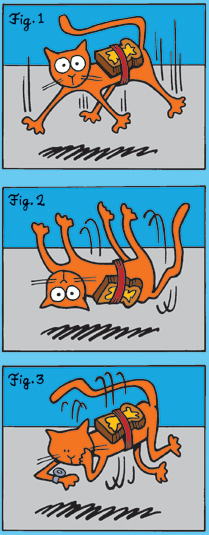Buttered Cat on:
[Wikipedia]
[Google]
[Amazon]
 The buttered cat paradox is a common joke based on the combination of two
The buttered cat paradox is a common joke based on the combination of two
Loopholes for the paradox
Butter Cats in popular culture Cultural conventions Humour Paradoxes Thought experiments
 The buttered cat paradox is a common joke based on the combination of two
The buttered cat paradox is a common joke based on the combination of two adage
An adage (; Latin: adagium) is a memorable and usually philosophical aphorism that communicates an important truth derived from experience, custom, or both, and that many people consider true and credible because of its longeval tradition, i.e. ...
s:
* Cats always land on their feet.
* Buttered toast always lands buttered side down.
The paradox arises when one considers what would happen if one attached a piece of buttered toast (butter side up) to the back of a cat, then dropped the cat from a large height. The buttered cat paradox, submitted by artist John Frazee of Kingston, New York, won a 1993 '' Omni'' magazine competition about paradoxes. The basic premise, stating the conditions of the cat and bread and posed as a question, was presented in a routine by comic and juggler Michael Davis, appearing on '' The Tonight Show with Johnny Carson'', July 22, 1988.
Thought experiments
Some people jokingly maintain that the experiment will produce an anti-gravity effect. They propose that as the cat falls towards the ground, it will slow down and start to rotate, eventually reaching a steady state of hovering a short distance from the ground while rotating at high speed as both the buttered side of the toast and the cat's feet attempt to land on the ground. In June 2003, Kimberly Miner won a Student Academy Award for her film ''Perpetual Motion''. Miner based her film on a paper written by a high-school friend that explored the potential implications of the cat and buttered toast idea.In humor
The faux paradox has captured the imagination of science-orientedhumorist
A humorist (American) or humourist (British spelling) is an intellectual who uses humor, or wit, in writing or public speaking, but is not an artist who seeks only to elicit laughs. Humorists are distinct from comedians, who are show business ...
s. In May 1992, the Usenet Oracle Digest #441 included a question from a supplicant asking about the paradox. Testing the theory is the main theme in an episode of the comic book strip '' Jack B. Quick''. The title character seeks to test this theory, leading to the cat hovering above the ground and the cat's wagging tail providing propulsion. The March 31, 2005, strip of the webcomic '' Bunny'' also explored the idea in the guise of a plan for a "Perpetual Motion MoggieToast 5k Power Generator", based on Sod's law. In ''Science Askew'', Donald E. Simanek comments on this phenomenon.
Brazilian energy drink brand Flying Horse released a 2012 award-winning commercial that simulates the recreation of this phenomenon, which is then used to create perpetual energy.
In reality
Cats possess the ability to turn themselves right side up in mid-air if they should fall upside-down, known as thecat righting reflex
The cat righting reflex is a cat's innate ability to orient itself as it falls in order to land on its feet. The righting reflex begins to appear at 3–4 weeks of age, and is perfected at 6–9 weeks. Cats are able to do this because they have a ...
. This enables them to land on their feet if dropped from sufficient height.
Toast, being an inanimate object, lacks both the ability and the desire to right itself. A study at Manchester Metropolitan University involving dropping 100 slices under laboratory conditions established that toast typically lands on the floor butter-side-down as a result of the manner in which it is typically dropped from a table, and the aerodynamic drag caused by the air pockets within the bread. The toast is typically butter-side-up when dropped. As it falls, it rotates; given the typical speed of rotation and the typical height of a table, a slice of toast that began butter-side-up on the table will land butter-side-down on the floor in 81% of cases.
See also
*High-rise syndrome
High-rise syndrome is a veterinary term for injuries sustained by a cat falling from a building, typically higher than two stories ().
Injuries sustained by cats falling
Common injuries sustained in cats after a fall include:
* Broken bones, m ...
* List of paradoxes
* Schrödinger's cat
References
External links
* {{cite journal, date=16 November 1996, title=Feedback, journal= New Scientist, issue=2056, url=https://www.newscientist.com/article/mg15220568.300Loopholes for the paradox
Butter Cats in popular culture Cultural conventions Humour Paradoxes Thought experiments